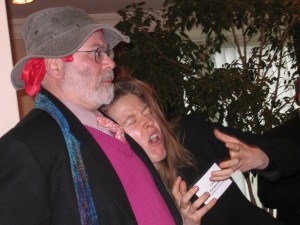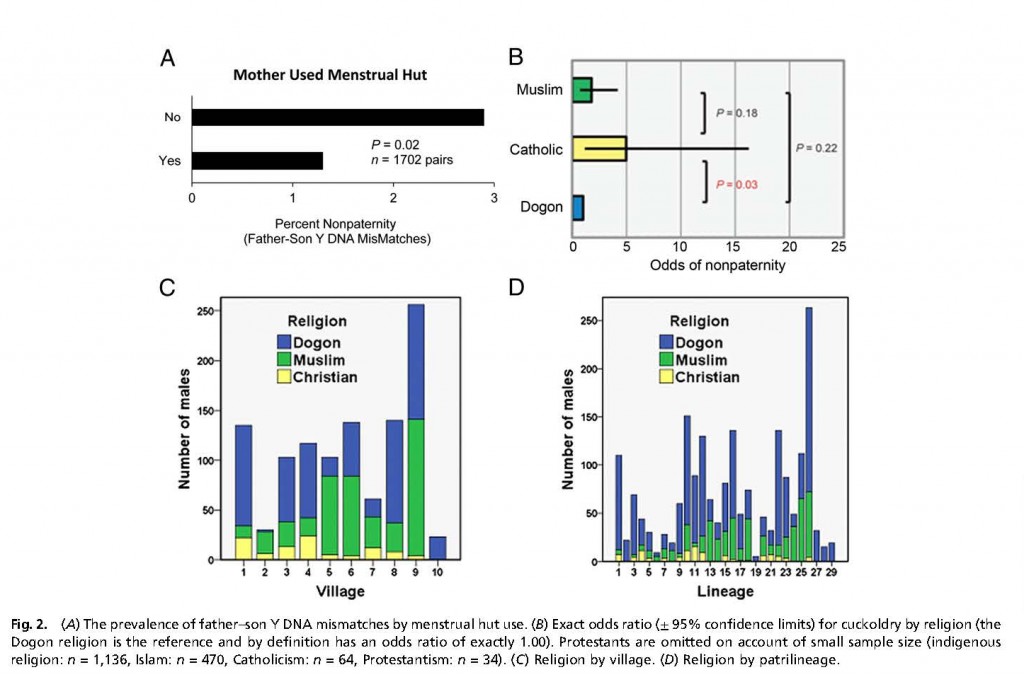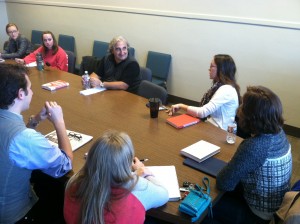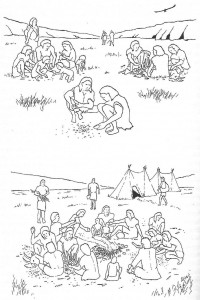
Bill Evans, from his blog Media Adaptor
I just met Bill Evans earlier this semester, who is a professor in the Department of Telecommunications & Film here at the University of Alabama & has had an abiding interest in evolutionary approaches to media analysis. I feel this connection is a new horizon for our EvoS program, as he is a resource for non-science students who nevertheless want to integrate an evolutionary perspective into their work. I hope he has the same sentiment & subsequent experience, as we are venturing into some joint research vis-a-vis evolution & media effects. I say this by way of introducing a piece I read by him (& that he summarized on this own blog here) that came out earlier this year in what I fear was the last issue of The Evolutionary Review, edited by EvoS Consortium & Newpaltzian friend & colleague Alice Andrews. The essay, “Television News Audiences as Tribes, Television News as Moral Alliance,” analyzes TV news as
an ingenious human innovation for surveying the emotionally salient aspects of a social environment that has become too vast to traverse and too disbanded to gossip about in person.
Following Robin Dunbar’s “social brain” model, once our alliances grow too large & hierarchical to monitor firsthand, we rely on proxy mechanisms or even stand-ins. (This is something like Richard Alexander’s suggestion that the arts are surrogate mechanisms for scenario-building but not quite. Rather they are probably complementary, but I am digressing & will have to work that out another time.) What we’re monitoring is the presence of friends or foes, things to approach or withdrawal from.
And to extend this line of Bill’s thought, I wonder if city dwellers rely on TV stand-ins more than rural denizens? Ironic as it might sound from a social intelligence perspective but intuitive from an urban studies one, overpopulation breeds distrust & the retraction of social networks. You are more likely to get mugged in broad daylight in a congested population than a small one, & though it might seem like I’m talking about NYC or something, these data come from studies of Japanese macaques in zoos where they are overprovisioned. Check out the high stress these monkeys experience in, I believe, the film “Monkey in the Mirror.”
Our friends or foes on TV are reflected in their moral stance, which we most quickly assess thru partisan political views. Though we look to other forms of media for the same signals of commitment to our cause,
television makes available the facial and vocal behavior of people…[so] viewers have more direct access than readers to the emotional state of quoted sources.
Despite the stance of objectivity previously associated with the gathering & dissemination of news, broadcasters have realized that emotional displays are more captivating for viewers & some have dispensed with any show of objectivity on networks. Instead, newscasters convey emotion through tone & expression, & producers “frame events as threats to viewers.”

Kelly Horwitz, Loretta Lynn, & Marvin Lucas care about children!
Bill also turned me on to some scholars I need to read up on. One, Jonathan Haidt, I am quite familiar with but have yet to read. Haidt’s deconstruction of the conservatism-liberalism spectrum as comprising 5 moral intuitions–care, fairness, loyalty, authority, & purity–is really quite compelling & mindblowing. Though conservatives & liberals often portray each other as somehow immoral & wonder at what appear to be immoral choices or judgments made by the others. Although we know there’s more nuance underlying these choices–for we all have friends or family who are on the opposite end of the political spectrum from ourselves–we judge the morality of strangers based merely on political affiliation (when campaigning for our non-partisan school board election recently, one drunk father of a UA student interrogated my wife: “What is Kelly Horwitz? What’s she want to do?” “Well,” my wife answered, “it’s a non-partisan election. Kelly simply wants what’s best for the children.” “The children?! Then she’s a democrat! We don’t vote for democrats!” the man spat & threw the info card she’d given him down). For instance, a friend of mine in grad school said she & her husband found it less complicated to simply tell their daughter that George Bush (prez at the time) & Ronald McDonald are evil than to explain any of the morally, politically, economically, or nutritionally complex subtext. I thought this was totally justified at the time, & my wife & I adopted a similar tack. Unteaching such reactionism has been our punishment. The point being that conservatives & liberals value the 5 moral intuitions in different concentrations, which gives them their flavors, “with liberal relying more heavily than conservatives on intuitions related to care and fairness. Liberals rely far less heavily than conservatives on intuitions related to loyalty, authority, and purity.”

Here is a clip (left) from our local media (Melissa Brown / Al.com). How do they feel about children? Delicious?
So, in a nutshell, TV news provides gossip about a whole panoply of people & issues, resplendent with facial expressions & tone heavy with implication. We find our allies on TV news, the ones that share our moral intuitions, & value their “gossip” over that of newscasters who are not part of our “alliance.”
The other scholar Bill turned me on to but have never heard of is Lisa Zunshine (watch I’m gonna go to the office Monday & find a book of hers sitting on my shelf that I’ve never gotten to–always happens that way when I admit my lack of literacy in public). She applies cognitive science to literary analysis &, in particular, theory of mind. This is really astounding. And obvious. She gives credit to Alan Parker, who apparently has pointed out that “novel reading is mind-reading.” I read parts of two articles of Zunshine’s available on her website (thanks for making it so easy!).

Not sure this photo is gonna win me friendship with Lisa Zunshine, but I found it online & it is awesome. What a great photo. And I’m being totally sincere. If you are looking to me for moral guidance, you already know that I am not mocking her, as any glance thru the jackassery of photos of me online can attest.
The first is a draft of a piece in progress for Interdisciplinary Literary Studies called “‘Theory of Mind’ as a Pedagogical Tool.” She says something I consider important & mention in a blog post I wrote up but am afraid to publish lest some journal editor refuses to consider a future version for peer review some day (just getting it out there that I thought of this, even though I can’t prove it–no doubt I read it somewhere else & forgot & think I thought of it myself anyway, so whatever):
…Our daily mind-reading is largely unselfconscious and mostly wrong. We don’t go around consciously articulating to ourselves our intuitions about other people’s mental states and we don’t really know what people are thinking—which doesn’t prevent us, however, from acting on our unarticulated, wrong, or only approximately correct intuitions.
I didn’t say the following though, but have only thought about it in inchoate, inarticulate ways for years, searching in my mind to explain why the arts seems intuitively important from an evolutionary perspective:
Fiction plays and experiments with the fact that we can’t stop reading minds and that we don’t read minds correctly. Both writing and reading fiction (as well as making and watching movies and plays) are thus profoundly social endeavors because they build on the same imperfect adaptations for attributing mental states that underlie our daily social interactions.
Furthermore, fiction embeds mental states within mental states within mental states. In a piece she wrote called “Style Brings in Mental States,” she points out that style itself can imply embedments that the reader intuits or projects, even when the rhetoric does not. For instance, she contrasts two pieces, written purposefully to be free of mental states. I’ll present them in the opposite order she did. The second reads
I drove the motorcycle half-way across the country, alone. I saw 21 states, 6 sunrises and 6 sunsets, while quietly sitting on a seat that measures no more than fourteen inches across. The seat is a magic carpet that whizzes through space at 80 miles per hour, supported by two wheels and an aluminum frame. i was connect to America through that seat, and those little foot pegs that jut out from the lower part of the bike. Motorcycling is high-speed meditation.
I’m not sure how the author thought that the metaphors of the magic carpet or being connected to America weren’t conveying mental states, but the whole piece, stitched together that way, conveys a whole theme that Zunshine outlines but which I can summarizes as exemplifying the Robert Pirsig’s narrator in Zen & the Art of Motorcycle Maintenance. I read that book over 25 years ago & still have a strong sense of the narrator’s mental state (wrong or not).
The piece, supposedly sans mental state insinuations, reads
I went grocery shopping two days ago. In the produce section, I got tomatoes, avocadoes, spinach, cilantro, green onion, and cauliflower. I also got fruit: apples, strawberries, grapes, and a watermelon. In the dairy section, I got milk, eggs, cheese, and yogurt. In the meat section, I got flounder and ground beef. I also bought olive oil, vinegar, dry beans, canned sardines, and paper towels.
By itself, this piece reads like it’s out of a children’s “how-to-read” book or an ESL workbook. Paraphrasing fiction & getting rid of mental states renders a fictional work purely factual, like Cliff Notes or something, which purposefully “downgrade the level of sociocognitive complexity…”
If we imagined the latter passage as part of a larger text, however, Zunshine points out,
Its very inanity would be perceived as stylized and thus working toward particular narrative ends. We will be talking, for example, about the speaker’s “flattening of affect” and wondering what caused this particular mental state in that character. In other words, what passes for the absence of mental states in the context of one genre (or, by extension, historical period) may acquire sociocognitive complexity when read within the context of a different genre (or a different historical period).
Finally, & what appeals to me as a diversity-loving anthropologist (& should appeal to any Darwinist, since variation is the necessary prerequisite for natural selection), is Zunshine’s summary.
What this all adds up to is that making strong “universal” claims about theory of mind and fiction hardly “flattens out variation”–instead, it forcefully focuses our attention on particularities of individual writing style and the context in which the text is read.














